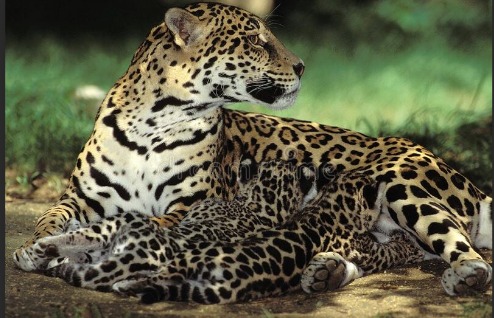I earn commissions if you shop through the links below at no additional cost to you.
Last Updated on March 23, 2023 by Jeremy
Having such an interesting world filled with birds, fish and 4-legged critters, I struggle to envision forests, lakes and crop-filled lands empty and uninhabited by wildlife. These animals are an essential part of our planet’s ecosystem, as they provide the nature with such important services.
Pollination, pest control, and nutrient cycling are all various jobs these animals produce and without them, our world wouldn’t operate, as its the circle-of-life.
With so many of these species facing threats, from habitat destruction such as logging and forestry, to other human-induced dilemmas such as poaching, today’s article will explore 15 fascinating facts about nature’s wildlife animals.
Going a step further, I will also highlight the importance we have as humans to protect them, as their situations can be quite complex. Let’s dive in!
Nature’s Wildlife Animals:
Lions
Lions they say are the only social cats that live in a group called “prides”. Prides, consist of several female lions called lionesses, their young (cubs) and only a few males.
You’ll notice them for their ferocious roar sounds which can be experienced up to 5 miles away through the sound.

Butterflies & Monarch Butterflies
All butterflies, including Monarch butterflies have a unique life cycle. It consists of four main stages, which is:
- Egg
- Larva, which is the caterpillar stage
- Pupa, which is the chrysalis stage
- Adult
These pollinating insects, like bees, help to fertilize plants and ensure that they produce seeds. Whereas the Monarch butterfly love to focus more so on wildflowers and other plants before they partake in their annual migration from Canada to Mexico, which can be up to 3,000 miles away.

Humpback Whales
The fifth largest whale in the oceans, called the Humpback whale is known for its singing, which can apparently last up to 20 minutes in length. However, they have also been victims of habitat loss and hunting regardless of the 50′ length and 40-ton weight!
To put it into a perspective, take a look at the chart below which compares a Humpback whale amongst its other whale cousins:

Kangaroos
Hopping over to these marsupials which are found down under in Australia, kangaroos can often be misassociated as a wallaby, but their size and more physique looking features make them stand out.
Having very powerful hind legs, kangaroos can travel really long distances, by hopping quickly. Mother kangaroos have pouches, which is where their baby kangaroos, called joeys, are born extremely undeveloped and spend several months inside.

Sea Turtles
Sea turtles are one of the oldest animals on earth, having been around for over 100 million years. If you ask Crush from the movie Finding Nemo, he’s “Hundred and fifty, dude, and still young. Rock on.”[mfn]https://www.imdb.com/title/tt0266543/characters/nm0004056[/mfn]
These creatures play an important part in the marine ecosystem, where they help maintain coral reefs and sea grass beds. What’s more, and similar to the Western Painted Turtle, they are the only animal that travels thousands of miles to lay their eggs at the same location they were born.

Polar Bears
Labeled the “largest land predators in the world”, Polar bears can weigh up to 1,500 pounds and can survive some harshest climates and conditions. These adaptable and magnificent looking creatures live in the Arctic where their habitat and food sources are being threatened.
To learn more about these amazing animals, have a 3-minute watch of this video that gives great facts and knowledge thanks to Natural Geographic:
Bald Eagles
These North American birds resemble “freedom and strength” in the USA, and are known for their sharp talons and powerful beaks.
Having a wingspan up to 7.5′, and a lifespan between 15 & 20 years, this carnivore bird of prey has 3 to 4 times better vision than humans and can hear almost identically to us as well.
They live mostly near coastal waters such as rivers and lakes, and can be found atop a nested tree that surprisingly can be rather large. According to the Guiness Book of World Records –
“The largest bird’s nest was built by a pair of bald eagles (Haliaeetus leucocephalus), and possibly their successors, near St Petersburg, Florida, USA and measured 2.9 m (9 ft 6 in) wide and 6 m (20 ft) deep. It was examined in 1963 and was estimated to weigh more than two tonnes (4,409 lb).”[mfn]https://www.guinnessworldrecords.com/world-records/largest-birds-nest/[/mfn]

Sharks
Sharks are considered to be just as old as sea turtles, if not longer. Over 400 million years apparently as they have survived multiple mass extinctions.
Not only that, there are between 400 to 1000 different species according to multiple different sources and they are the most successful predators in the ocean known to our lifespan.

Elephants
Elephants are the largest land animal in our world, but once upon a time it was a dinosaur so we’re told.
These mammals are known to have the longest gestation period of any animal on earth, being an astounding 22 months.
Mind = Blown!
Problems that surround these elephants have been the ongoing poaching of these mammals for their ivory tusks. Certainly, an unfortunate issue!

Platypus
Beaver-ducks as I call them, or The platypus is one of the few mammals that lay eggs. With a unique sense called electro-location, the platypus is able to detect the electric fields that are generated by other animals. This becomes extremely useful in a hunted vs hunting scenario.
Have a look at this under 2-minute video of the Platypus and its “sixth sense”:
Honeybees
We already know that bees can pollinate trees from a previous article written here: Do Bees Pollinate Trees? – 1 curious bee!
But did you know what else makes honeybees essential to the global food supply? Pollinating all sorts of plants and crops, allows them to create honey, beeswax, and other valuable human consumed products. Without bees, nature wouldn’t survive, as there aren’t enough pollinators to take over.

Jaguars
Another of Americas largest cats, Jaguars are considered a keystone species, and are also, really excellent swimmers. Their presence is very valuable in maintaining the health and balance of their ecosystem.
They have the strongest jawline to catch their prey and the swimmer skills they acquire is by diving in after their meals.
The jaguars face threats from trees and animals every year affecting their population.

African wild dogs
Comparable to a Hyena but unlike a Dingo, the African wild dog hunts in packs and is one of the most social carnivores.
Unfortunately, there are only around 6,000 of these dogs left in the wild making them extremely endangered. Having a lifespan of only 11 years, you can find these wild creatures near Zimbabwe feasting mainly on the Thomson’s Gazelle.

Red Pandas
What would you say to spend most of your life in a tree, eating? That’s what these red racoon-like animals do. What’s more is that they are endangered with approximately 10,000 red pandas alive in the wild to date.
As for how often they eat – up to 13 hours a day! Sure its only bamboo, flowers and birds, but that’s probably why they’re endangered.

Rhinoceroses
Another of the largest land animals, next to the elephant, have been around for over 50 million years. They too, are threatened by poachers, instead for their horns. Reasoning for such is its believed to have medicinal properties.
Dating back to the Dinosaur era, have a watch of this 15-minute video to watch the evolution of the Rhino – extremely fascinating:
Conclusion
As you can see, a lot of these animal mentions are just a small sample of the fascinating diversity of wildlife on our planet. Protecting these animals is extremely crucial to maintain the health and balance of ecosystems, plus it makes it extraordinary to witness the wild of our planet.
By protecting wildlife, we eliminate the ripple effect it could have on our planet. For instance, without bees there’s no pollination, without pollination there are no flowers that regrow, without plants there is no clean air and so on and so forth. This also means we have enough food to feed the planets’ population. Continuing with bees, if they aren’t pollinating, you don’t get honey.
Of course, there are some animals that have an abundance of them and this becomes an example of wild game meat, however nature’s wildlife animals are unique in a sence where they have cultural and aesthetic value. The bald eagle for instance has been a proud logo of the United States dating back to the 1700s, and its also a symbol of Native Indians.
If you gained new knowledge of some of these animals today or found this article as fascinating as many of the creatures listed above, feel free to acknowledge it within the comments at the bottom of this page.
Until then…
Earth is Heart!






